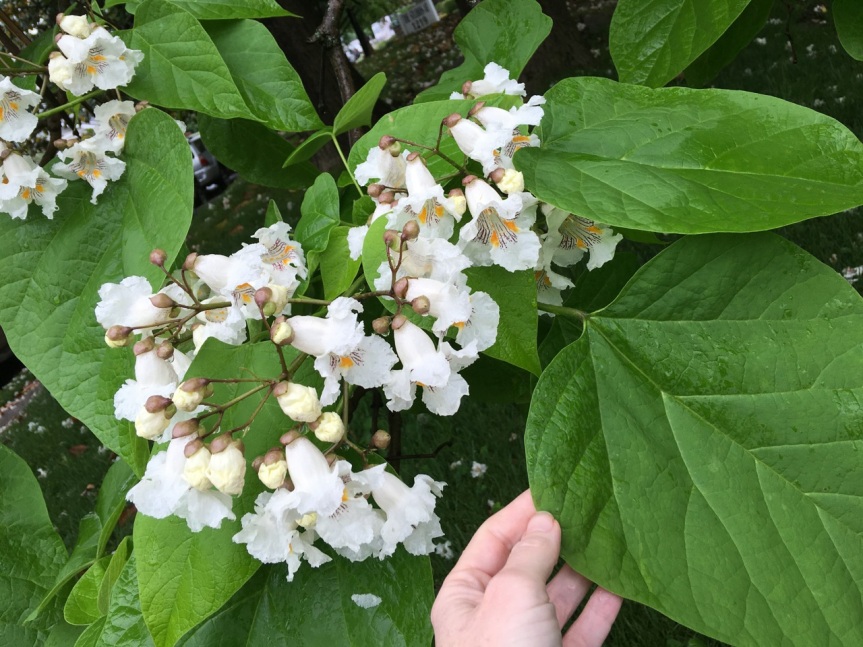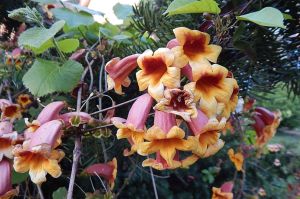Catalpas are in full bloom in Nashville. These are the big trees with leaves like giant hearts; with flowers like white, ruffled bells; and pretty soon, with dangling pods like green cigars. Hearts, bells, cigars. Catalpas bring out the similes.
They bring out the bees, too. The bells are full of fragrance and nectar. I hope you can find a tree and poke your face into a pyramid of blossoms.
And if you fancy, pluck just one flower and peep inside:
Look at the painted landing strips showing bees just where to aim.
Look at the pollen-coated anthers on the ceiling which will brush against bees as they bumble.
Look at the hole where the bloom had been attached: like a pierced plastic flower from a Hawaiian lei, but it’s a pierced real flower from a Tennessee tree.
Rip the flower at the hole and see the sticky shine. This is where the nectar pooled. This is where to lick.

Catalpas are in the same little botanical family as crossvine and trumpet vine: two sprawly vines with orange/red/yellow trumpet blooms. The word “tropical” is mentioned in descriptions of all three, and you can see why. The funny thing is that all are native. As redneck as red cedar, really.

Catalpas come in two flavors: North (Catalpa speciosa) and South (Catalpa bignonioides). Both are planted here as landscape ornamentals. I suspect the trees I see around Vanderbilt and Music Row are all the Northern kind, but I can only be sure about the ones I walk up to. I almost don’t care. Not when faced with the limited-time only extravagance of fragrant white frills.
Where are the catalpas?
If you are in Nashville, go now to 21st Avenue South, by Vanderbilt’s Central Library. The balcony is bookended by two catalpas.
My favorite one is on Music Row, in the corner of the parking lot of 1207 17th Ave. South. Favorite = low branches to reach, sniff, and inspect.
Tell me if you have a favorite catalpa, and where?
I also mentioned a few locations in my winter post about the fantastic catalpa pod, here.

North vs. South
Should you find yourself curious about Northern vs Southern catalpa, read on:
The septum and beard of the pod and seed are slightly different, and I will never, ever be able to remember which is what, but this is why I bought the $40 Guide to the Vascular Plants of Tennessee and why it stays in Ready Reference (the dining room table).
There are other differences:
•How hard the wood (Northern is harder), which matters if you are making railroad ties.
•The shape of the leaf tip (Northern is longer, pointier), which matters if your leaf press is small.
•The smell of a leaf when crushed: southern is stinky. Why?
•The size of each flower: Northern flowers are about 2 cm broader and the lower lip is centered with one shallow notch.
•The likelihood of hosting “catalpa worms:” the larvae of the catalpa sphinx moth (Ceratomia catalpae). Southern is more likely to host the caterpillar and I wish I knew why. I do know why fisherfolk like the “worm,” but I will not relay the particulars because the caterpillar does not fare well, although it does become fare well. (Details for those thrilled by free bait are here.)
0 0 0 0 0 0
Joanna Brichetto is a certified Tennessee Naturalist, educator and writer in Nashville. Look Around: Nearby Nature is her playground (where she hardly ever refers to herself in the third person). Words and images here are the property of the author and may not be used without written permission.
Thanks for visiting.

We have Catalpas here in Philadelphia, too. Probably the Northern kind? Just saw two red buds here on the Cathedral Village lawn!! AMAZING!